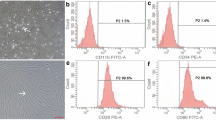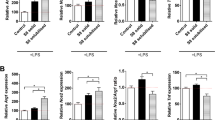Abstract
Here, we aim at developing a novel biomatrix from decellularized bovine spinal meninges for tissue engineering and regenerative medicine applications. Within this concept, the bovine spinal meninges were decellularized using 1% Triton X-100 for 48 h, and residual nuclear content was determined with double-strand DNA content analysis and agarose gel electrophoresis. The major matrix components such as sulfated GAGs and collagen before and after the decellularization process were analyzed with DMMB, hydroxyproline assay and SDS-PAGE. Subsequently, the native bovine spinal meninges (nBSM) and decellularized BSM (dBSM) were physiochemically characterized via ATR-FTIR spectroscopy, TGA, DMA and tensile strength test. The dsDNA content in the nBSM was 153.39 ± 53.93 ng/mg dry weight, versus in the dBSM was 39.47 ± 4.93 ng/mg (n = 3) dry weight and DNA fragments of more than 200 bp in length were not detected in the dBSM by agarose gel electrophoresis. The sulfated GAGs contents for nBSM and dBSM were observed to be 10.87 ± 1.2 and 11.42 ± 2.01 μg/mg dry weight, respectively. The maximum strength of dBSM in dry and wet conditions was found to be 19.67 ± 0.21 MPa and 13.97 ± 0.17 MPa, while nBSM (dry) was found to be 26.26 ± 0.28 MPa. MTT, SEM, and histology results exhibited that the cells attached to the surface of dBSM, and proliferated on the dBSM. In conclusion, the in vitro preliminary study has demonstrated that the dBSM might be a proper and new bioscaffold for tissue engineering and regenerative medicine applications.







Similar content being viewed by others
References
Albuschies J, Vogel V (2013) The role of filopodia in the recognition of nanotopographies. Sci Rep. https://doi.org/10.1038/srep01658
Arslan YE, Sezgin Arslan T, Derkus B et al (2017) Fabrication of human hair keratin/jellyfish collagen/eggshell-derived hydroxyapatite osteoinductive biocomposite scaffolds for bone tissue engineering: from waste to regenerative medicine products. Colloids Surf B Biointerfaces 154:160–170. https://doi.org/10.1016/j.colsurfb.2017.03.034
Arslan YE, Galata YF, Sezgin Arslan T, Derkus B (2018) Trans-differentiation of human adipose-derived mesenchymal stem cells into cardiomyocyte-like cells on decellularized bovine myocardial extracellular matrix-based films. J Mater Sci Mater Med 29:127. https://doi.org/10.1007/s10856-018-6135-4
Arslan YE, Efe B, Sezgin Arslan T (2019a) A novel method for constructing an acellular 3D biomatrix from bovine spinal cord for neural tissue engineering applications. Biotechnol Prog. https://doi.org/10.1002/btpr.2814
Arslan YE, Ozudogru E, Sezgin Arslan T et al (2019b) Sophisticated biocomposite scaffolds from renewable biomaterials for bone tissue engineering. In: Duscher D, Shiffman MA (eds) Regenerative medicine and plastic surgery. Springer, Cham, pp 17–31. https://doi.org/10.1007/978-3-030-19958-6_4
Badylak SF (2004) Xenogeneic extracellular matrix as a scaffold for tissue reconstruction. Transpl Immunol 12:367–377. https://doi.org/10.1016/j.trim.2003.12.016
Batioglu-Karaaltin A, Karaaltin MV, Ovali E et al (2015) In vivo tissue-engineered allogenic trachea transplantation in rabbits: a preliminary report. Stem Cell Rev Rep 11:347–356. https://doi.org/10.1007/s12015-014-9570-8
Chen F-M, Liu X (2016) Advancing biomaterials of human origin for tissue engineering. Prog Polym Sci 53:86–168. https://doi.org/10.1016/j.progpolymsci.2015.02.004
Chen R-N, Ho H-O, Tsai Y-T, Sheu M-T (2004) Process development of an acellular dermal matrix (ADM) for biomedical applications. Biomaterials 25:2679–2686. https://doi.org/10.1016/j.biomaterials.2003.09.070
Chi Ting Au-Yeung G, Sarig U, Sarig H et al (2017) Restoring the biophysical properties of decellularized patches through recellularization. Biomater Sci 5:1183–1194. https://doi.org/10.1039/C7BM00208D
Choe JA, Jana S, Tefft BJ et al (2018) Biomaterial characterization of off-the-shelf decellularized porcine pericardial tissue for use in prosthetic valvular applications. J Tissue Eng Regen Med 12:1608–1620. https://doi.org/10.1002/term.2686
Coronado RE, Somaraki-cormier M, Natesan S et al (2018) Decellularization and solubilization of porcine liver for use as a substrate for porcine hepatocyte culture: method optimization and comparison. Cell Transpl 26:1840–1854. https://doi.org/10.1177/0963689717742157
Crapo PM, Gilbert TW, Badylak SF (2011) An overview of tissue and whole organ decellularization processes. Biomaterials 32:3233–3243. https://doi.org/10.1016/j.biomaterials.2011.01.057
Decimo I, Fumagalli G, Berton V et al (2012) Meninges: from protective membrane to stem cell niche. Am J Stem Cells 1:92–105
Erten E, Arslan YE (2018) The great harmony in translational medicine: biomaterials and stem cells. In: Turksen K. (ed) Cell Biology and Translational Medicine, Volume 4. Advances in experimental medicine and biology, vol 1119. Springer, Cham pp 21–39. https://doi.org/10.1007/5584_2018_231
Erten E, Sezgin Arslan T, Derkus B, Arslan YE (2016) Detergent-free decellularization of bovine costal cartilage for chondrogenic differentiation of human adipose mesenchymal stem cells in vitro. RSC Adv 6:94236–94246. https://doi.org/10.1039/C6RA16647D
Furth ME, Atala A, Van Dyke ME (2007) Smart biomaterials design for tissue engineering and regenerative medicine. Biomaterials 28:5068–5073. https://doi.org/10.1016/j.biomaterials.2007.07.042
Gilpin A, Yang Y (2017) Decellularization strategies for regenerative medicine: from processing techniques to applications. Biomed Res Int 2017:1–13. https://doi.org/10.1155/2017/9831534
Hinderer S, Layland SL, Schenke-Layland K (2016) ECM and ECM-like materials: biomaterials for applications in regenerative medicine and cancer therapy. Adv Drug Deliv Rev 97:260–269. https://doi.org/10.1016/j.addr.2015.11.019
Hussein KH, Park KM, Kang KS, Woo HM (2016) Biocompatibility evaluation of tissue-engineered decellularized scaffolds for biomedical application. Mater Sci Eng C 67:766–778. https://doi.org/10.1016/j.msec.2016.05.068
Jun LY, Mubarak NM, Yon LS et al (2019) Immobilization of peroxidase on functionalized MWCNTs-buckypaper/polyvinyl alcohol nanocomposite membrane. Sci Rep 9:2215. https://doi.org/10.1038/s41598-019-39621-4
Kaczmarek B, Sionkowska A, Gołyńska M et al (2018) In vivo study on scaffolds based on chitosan, collagen, and hyaluronic acid with hydroxyapatite. Int J Biol Macromol 118:938–944. https://doi.org/10.1016/j.ijbiomac.2018.06.175
Kayalioglu G (2009) The vertebral column and spinal meninges. In: The spinal cord. Elsevier, pp 17–36. https://doi.org/10.1016/B978-0-12-374247-6.50007-9
Ke Y, Li Y, Wang Z-Y (2012) The changes of fourier transform infrared spectrum in rat brain*. J Forensic Sci 57:794–798. https://doi.org/10.1111/j.1556-4029.2011.02036.x
Lee DJ, Padilla R, Zhang H et al (2014) Biological assessment of a calcium silicate incorporated hydroxyapatite-gelatin nanocomposite: a comparison to decellularized bone matrix. Biomed Res Int 2014:1–12. https://doi.org/10.1155/2014/837524
Mercier F, Arikawa-Hirasawa E (2012) Heparan sulfate niche for cell proliferation in the adult brain. Neurosci Lett 510:67–72. https://doi.org/10.1016/j.neulet.2011.12.046
Mercier F, Hatton GI (2001) Connexin 26 and basic fibroblast growth factor are expressed primarily in the subpial and subependymal layers in adult brain parenchyma: roles in stem cell proliferation and morphological plasticity? J Comp Neurol 431:88–104. https://doi.org/10.1002/1096-9861(20010226)431:1%3c88:AID-CNE1057%3e3.0.CO;2-D
Nardo T, Carmagnola I, Ruini F et al (2017) Synthetic biomaterial for regenerative medicine applications. In: Kidney transplantation, bioengineering and regeneration. Elsevier, pp 901–921. https://doi.org/10.1016/B978-0-12-801734-0.00065-5
Neethling WML, Puls K, Rea A (2018) Comparison of physical and biological properties of CardioCel® with commonly used bioscaffolds. Interact CardioVascul Thorac Surg 26:985–992. https://doi.org/10.1093/icvts/ivx413
O’Brien FJ (2011) Biomaterials & scaffolds for tissue engineering. Mater Today 14:88–95. https://doi.org/10.1016/S1369-7021(11)70058-X
Patel N, Kirmi O (2009) Anatomy and imaging of the normal meninges. Semin Ultrasound, CT MRI 30:559–564. https://doi.org/10.1053/j.sult.2009.08.006
Petreaca M, Martins-Green M (2011) Cell-ECM interactions in repair and regeneration. In: Principles of regenerative medicine. Elsevier, pp 19–65. https://doi.org/10.1016/B978-0-12-381422-7.10002-1
Rahman S, Griffin M, Naik A et al (2018) Optimising the decellularization of human elastic cartilage with trypsin for future use in ear reconstruction. Sci Rep 8:3097. https://doi.org/10.1038/s41598-018-20592-x
Rashtbar M, Hadjati J, Ai J et al (2017) Characterization of decellularized ovine small intestine submucosal layer as extracellular matrix-based scaffold for tissue engineering. J Biomed Mater Res B Appl Biomater. https://doi.org/10.1002/jbm.b.33899
Reiss K, Mentlein R, Sievers J, Hartmann D (2002) Stromal cell-derived factor 1 is secreted by meningeal cells and acts as chemotactic factor on neuronal stem cells of the cerebellar external granular layer. Neuroscience 115:295–305. https://doi.org/10.1016/S0306-4522(02)00307-X
Scarritt M, Murdock M, Badylak SF (2019) Biologic scaffolds composed of extracellular matrix for regenerative medicine. In: Principles of regenerative medicine. Elsevier, pp 613–626. https://doi.org/10.1016/B978-0-12-809880-6.00035-7
Sicari BM, Londono R, Badylak SF (2014) Extracellular matrix as a bioscaffold for tissue engineering. In: Tissue engineering, 2nd edn. Elsevier, pp 149–175. https://doi.org/10.1016/B978-0-12-420145-3.00005-5
Siegenthaler JA, Ashique AM, Zarbalis K et al (2009) Retinoic acid from the meninges regulates cortical neuron generation. Cell 139:597–609. https://doi.org/10.1016/j.cell.2009.10.004
Song M, Liu Y, Hui L (2017) Preparation and characterization of acellular adipose tissue matrix using a combination of physical and chemical treatments. Mol Med Rep 17:138–146. https://doi.org/10.3892/mmr.2017.7857
Srokowski EM, Woodhouse KA (2017) 2.20 Decellularized scaffolds. In: Comprehensive biomaterials II. Elsevier, pp 452–470. https://doi.org/10.1016/B978-0-08-100691-7.00055-0
Stylianopoulou F, Herbert J, Soares MB, Efstratiadis A (1988) Expression of the insulin-like growth factor II gene in the choroid plexus and the leptomeninges of the adult rat central nervous system. Proc Natl Acad Sci 85:141–145. https://doi.org/10.1073/pnas.85.1.141
Taylor DA, Sampaio LC, Ferdous Z et al (2018) Decellularized matrices in regenerative medicine. Acta Biomater 74:74–89. https://doi.org/10.1016/j.actbio.2018.04.044
Vishwakarma SK, Bardia A, Lakkireddy C et al (2018) Bioengineering human neurological constructs using decellularized meningeal scaffolds for application in spinal cord injury. Front Bioeng Biotechnol 6:1–19. https://doi.org/10.3389/fbioe.2018.00150
Vogler EA (2013) Surface modification for biocompatibility. In: Engineered biomimicry. Elsevier, pp 189–220. https://doi.org/10.1016/B978-0-12-415995-2.00008-8
Wu G, Bazer Fuller W, Burghardt RC et al (2011) Proline and hydroxyproline metabolism: implications for animal and human nutrition. Amino Acids 40:1053–1063. https://doi.org/10.1007/s00726-010-0715-z
Yoon JH, Halper J (2005) Tendon proteoglycans: biochemistry and function. J Musculoskelet Neuronal Interact 5:22–34
Acknowledgements
The authors gratefully acknowledge financial support from the Ministry of Science, Industry, and Technology, Republic of Turkey (Project ID. 0089.TGSD.2013). We wish to thank Canakkale Onsekiz Mart University, Science and Technology Application & Research Center for collaborating with analyzes.
Author information
Authors and Affiliations
Corresponding author
Ethics declarations
Conflicts of interest
The authors declare no competing interests.
Additional information
Publisher's Note
Springer Nature remains neutral with regard to jurisdictional claims in published maps and institutional affiliations.
Rights and permissions
About this article
Cite this article
Ozudogru, E., Arslan, Y.E. A preliminary study on the development of a novel biomatrix by decellularization of bovine spinal meninges for tissue engineering applications. Cell Tissue Bank 22, 25–38 (2021). https://doi.org/10.1007/s10561-020-09859-8
Received:
Accepted:
Published:
Issue Date:
DOI: https://doi.org/10.1007/s10561-020-09859-8




